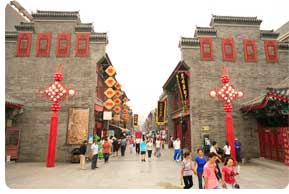 Old Culture Street
Old Culture Street
古文化街
The Ancient Culture Street, in the northeastern part of Lanjie, extends to the north and south of the Mazu Palace (Tianhou Gong). The square in front the palace is big enough to hold a thousand people. Built around the square are arts and ballad halls, where fine performances are given on almost all festival days. A spectacular "Imperial Festival" is held in and around the square every year on the 23rd day of the third lunar month.
A giant archway inscribed with the words "an Old Neighbourhood of Tianjin" stands at the entrance to the street, and behind the archway is a street of 600 metres long lined with buildings in the Qing-dynasty architectural style. There are so many different buildings that the eye cannot take them in all at once. Walking by these buildings with grey walls and decorated with colorful streamers is like walking into the past. Past. The most note-worthy things are the boards inscribed with the names of shops and with couplets at the shop fronts, which are written by famous calligraphers.
Walking through the archway, the first shop that comes in sight is the shop of Zhang, the Sculptor of Clay Figurines. There is also a special shop selling the famous New Year pictures of Yangliuqing.
Studio of Living Stone is the name of another eye-catching shop because it is decorated with a long string of multiple national flags and advertisements written in both Chinese and English. Most of the things sold in the shop are curios, including portraits of emperors of the Ming and Qing dynasties.
Next to the studio is a stall selling "cha tang", a soup made with millet flour and brown sugar. To attract patrons, the stall keeper demonstrates his skill of holding four bowls in one hand while pouring boiling water into them from a huge pot with a dragon-shaped spout.
Within the confines of the street is the "Mazu Palace" (Tianhou Gong), paying tribute to the Goddess of the sea. The temple was apparently built in 1326 AD in deference to the heavenly Goddess and in hope of protection for Tianjin's ocean going population. Since then the temple has been renovated a number of times. In 1984, it was turned into a museum displaying local customs, including some fine examples of the Tianjin clay works and woodblocks from the nearby village of Yangliuqing
|



